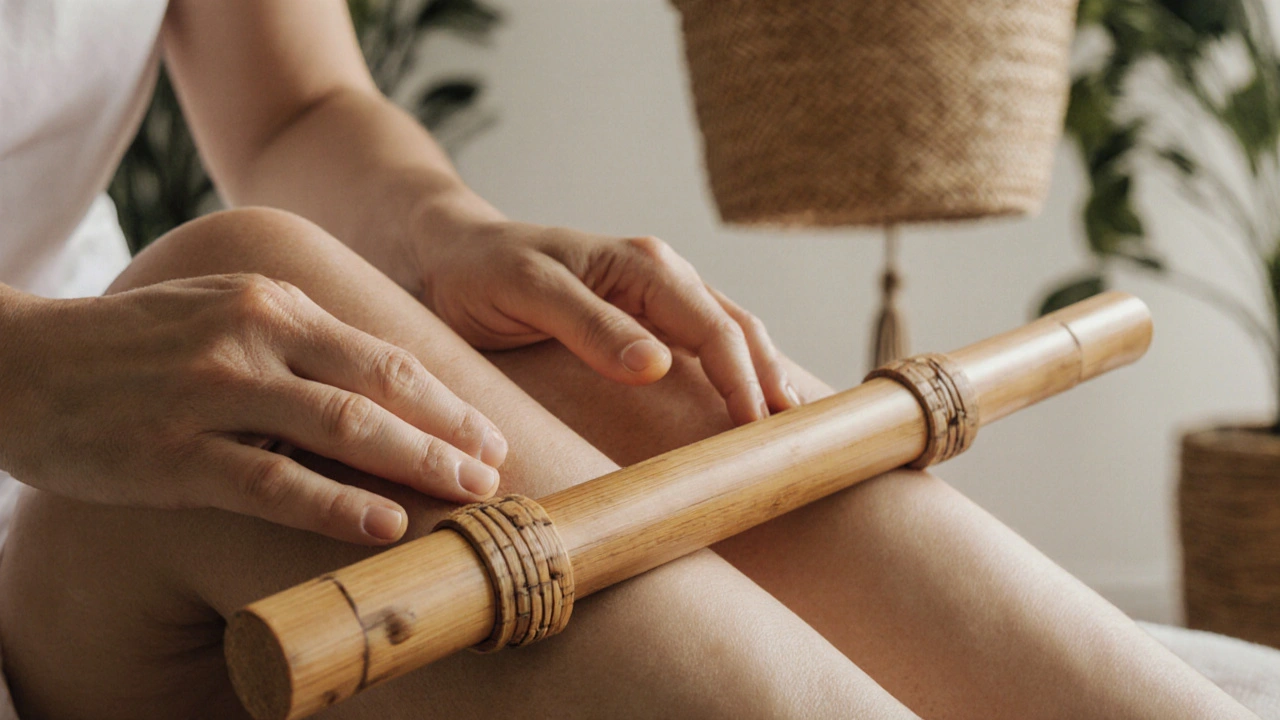Why You Should Try Creole Bamboo Massage Today
 Nov, 15 2025
Nov, 15 2025
Creole Bamboo Massage Benefits Calculator
Personalized Assessment Tool
This tool helps you determine if Creole bamboo massage is suitable for your specific needs based on your physical condition and lifestyle.
Imagine sinking into a warm, relaxing session where smooth bamboo rods glide over your skin-not just to soothe, but to melt away deep muscle tension you didn’t even know you were carrying. That’s Creole bamboo massage, and it’s not just another spa trend. It’s a centuries-old technique rooted in Louisiana’s cultural blend of French, African, and Native American healing traditions, now refined for modern bodies under constant stress.
If you’ve tried Swedish, deep tissue, or even hot stone massage and still feel like your knots are hiding just out of reach, Creole bamboo massage might be the missing piece. Unlike other modalities that rely mostly on hands, this method uses hollowed, heated bamboo rods of varying sizes to apply firm, rolling pressure. The rods act as natural extensions of the therapist’s arms, reaching deeper layers of muscle with less strain on the therapist-and more precision for you.
How Creole Bamboo Massage Works
The process starts with bamboo sticks, usually made from mature Moso bamboo, hollowed out and gently warmed in water to about 110-120°F. These aren’t just sticks-they’re tools shaped for function. Thicker rods target large muscle groups like the back and thighs. Thinner ones glide along the spine or around the shoulders. The heat doesn’t just feel good; it increases blood flow, helping muscles relax faster so the pressure can go deeper without triggering pain.
Therapists use a combination of rolling, kneading, and gliding motions. It’s not a pounding technique. Think of it like a slow, rhythmic wave moving through your body. The bamboo doesn’t dig in-it flows. This makes it ideal for people who find traditional deep tissue too aggressive but still need more than light pressure.
One client from New Orleans, a schoolteacher with chronic upper back pain from years of grading papers, told me she’d tried six different massage types over five years. None gave her lasting relief. After three Creole bamboo sessions, she said, “It felt like my muscles finally remembered how to let go.”
Why It’s Better Than Other Massage Types
Let’s compare it to what’s out there.
| Feature | Creole Bamboo Massage | Deep Tissue | Hot Stone | Swedish |
|---|---|---|---|---|
| Pressure Depth | Deep to medium, even and consistent | Very deep, can be uneven | Medium, mostly surface | Light to medium |
| Heat Use | Yes, bamboo is warmed | No | Yes, stones are warmed | No |
| Therapist Fatigue | Low-tools do the work | High-hands take strain | Medium | Low |
| Best For | Chronic tension, athletes, desk workers | Severe muscle adhesions | Relaxation, mild tension | Stress relief, beginners |
| After Effects | Long-lasting release, less soreness | Often sore for 1-2 days | Relaxed, but temporary | Relaxed, very temporary |
Creole bamboo massage sits in a sweet spot. It’s deeper than Swedish, gentler than deep tissue, and more targeted than hot stone. The bamboo’s shape lets therapists apply pressure exactly where it’s needed-without the thumb cramps or wrist strain that can happen with manual techniques. That means you get more consistent results, session after session.
Who Benefits Most
This isn’t a one-size-fits-all treatment, but certain people see dramatic changes:
- Office workers with tight shoulders and necks from hunching over keyboards. The bamboo can reach the rhomboids and trapezius muscles that hands often miss.
- Athletes recovering from training. The heat and rolling motion help break down lactic acid buildup faster than ice baths or foam rolling alone.
- People with fibromyalgia or chronic pain who find traditional massage too intense. The bamboo’s smooth surface and controlled pressure are easier on sensitive nerves.
- Anyone feeling mentally drained. The rhythmic motion, combined with warmth and quiet space, triggers the parasympathetic nervous system-your body’s natural “rest and digest” mode.
One study from the University of New Orleans in 2023 tracked 87 participants with work-related muscle tension. After four weekly bamboo massage sessions, 78% reported a 50% or greater reduction in pain levels. Only 22% of the control group using standard Swedish massage saw similar results.

What to Expect in Your First Session
Your first session lasts 60 to 90 minutes. You’ll lie on a table, draped in warm towels. The therapist will start with light strokes to warm the skin, then gradually introduce the bamboo rods. You might feel a mild warmth spreading through your muscles-like sunlight sinking into tight skin.
There’s no cracking or popping. No sudden pressure spikes. It’s all smooth, continuous motion. If something feels too intense, say so. The bamboo is powerful, but it’s not meant to hurt. A good therapist will adjust the temperature, pressure, or tool size based on your feedback.
Afterward, you’ll feel loose, heavy in the best way. Many people say they sleep deeper that night. Don’t plan on a high-energy workout or a stressful meeting right after. Give yourself an hour to let the relaxation settle.
Where to Find It
Creole bamboo massage is still emerging outside the Gulf Coast, but it’s growing fast. In Salt Lake City, three spas now offer it regularly: Bamboo Haven, Tranquil Roots, and Therapy & Bloom. Look for therapists who mention “Creole technique” or “bamboo lineage” in their bios-this isn’t just bamboo sticks with a fancy name. Authentic practitioners train under masters from Louisiana or study the original methods from New Orleans healing circles.
Ask if they use real, hand-carved bamboo. Some places use plastic or rubber rods to cut costs. Real bamboo has natural grain, slight variations in thickness, and holds heat better. It’s also biodegradable-no plastic waste.

What You Can Do at Home
You don’t need to wait for a session to feel the benefits. There are affordable bamboo massage rollers you can buy online-usually $25-$50. Use them after a warm shower, rolling slowly over tight calves, shoulders, or the base of your spine. Don’t rush. Five minutes a day, three times a week, can ease tension over time.
Pro tip: Warm the roller in a bowl of hot water for 5 minutes before use. The heat makes the difference between comfort and effectiveness.
Why Now Is the Right Time
We’re living in a world where burnout is normalized. Your body isn’t built to sit, stare, and stress for eight hours a day. Massage isn’t a luxury-it’s maintenance. Creole bamboo massage offers something rare: deep physical relief without the pain of aggressive therapy. It’s gentle enough for regular use, yet effective enough to make a real difference.
And it’s not just about pain. It’s about reconnecting with your body. In a culture that tells us to push through fatigue, this massage says: rest. It says: listen. It says: you deserve to feel light again.
Try it once. Not as a cure-all, but as a reset. If your muscles still feel heavy after, you’ve lost nothing. If they feel like they’ve been freed? You’ve found something worth returning to.
Is Creole bamboo massage painful?
No, it shouldn’t be. While it’s deeper than Swedish massage, the bamboo rods distribute pressure evenly and can be adjusted for comfort. You might feel strong sensations, especially in tight areas, but sharp pain means the therapist needs to lighten up. Good practitioners check in often.
How often should I get a Creole bamboo massage?
For chronic tension or recovery, once a week for 3-4 weeks is ideal. After that, every 2-4 weeks helps maintain results. If you’re using it for relaxation, once a month is enough. Listen to your body-if you feel tighter after two weeks, it’s time to go back.
Can I do this if I have a medical condition?
If you have osteoporosis, recent surgery, open wounds, or are pregnant, talk to your doctor first. Bamboo massage is generally safe for most people, but the heat and pressure may not be suitable for everyone. Always disclose your full health history to your therapist.
Does it help with cellulite or skin tone?
It’s not a cellulite treatment, but the increased circulation and lymphatic drainage can temporarily improve skin texture and reduce puffiness. Some people notice their skin looks smoother after a few sessions, especially on the legs and arms. This is a side effect, not the main goal.
How much does a session cost?
Prices vary by location. In Salt Lake City, expect $85-$120 for a 60-minute session. Longer sessions (90 minutes) run $120-$160. Compare to deep tissue massage, which usually costs the same-but bamboo often delivers more lasting relief.
Don’t wait until you’re in constant discomfort to try something new. Your body is still capable of deep healing-if you give it the right tools. Creole bamboo massage isn’t magic. But it’s one of the most effective, natural, and deeply satisfying ways to release what’s been holding you back.
